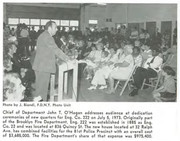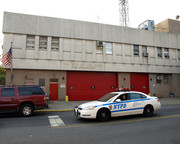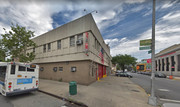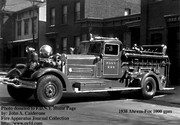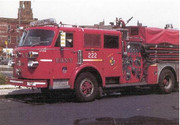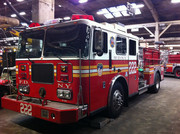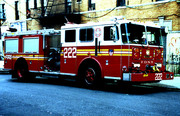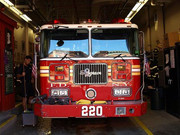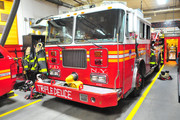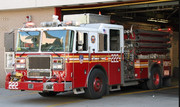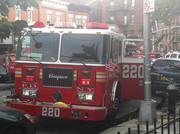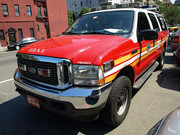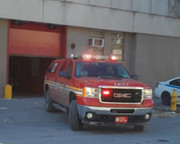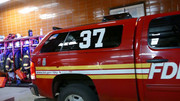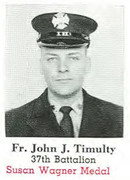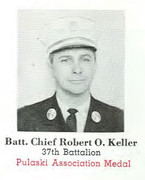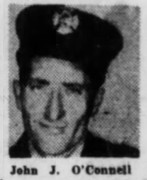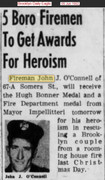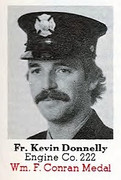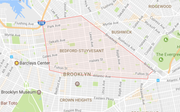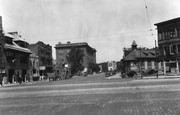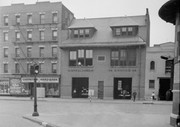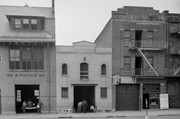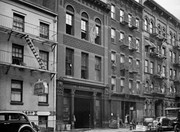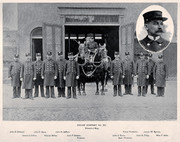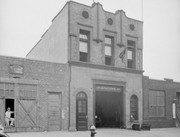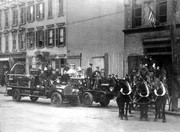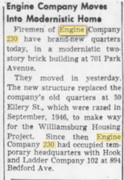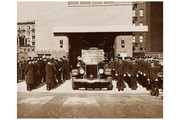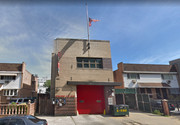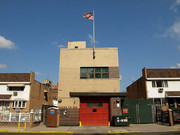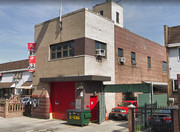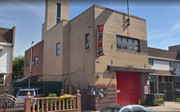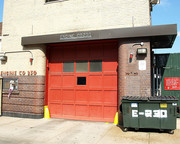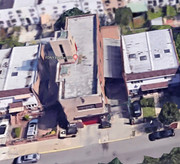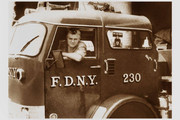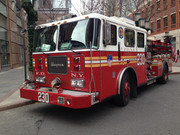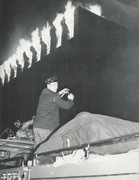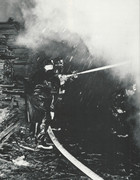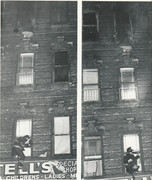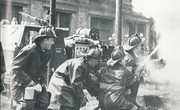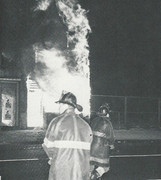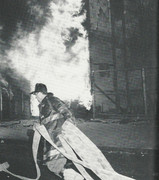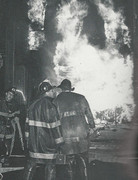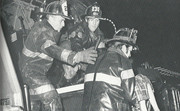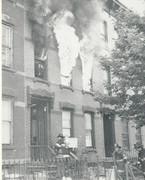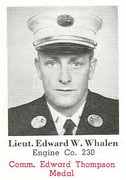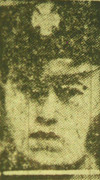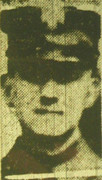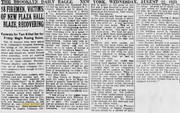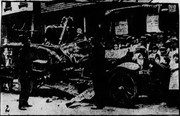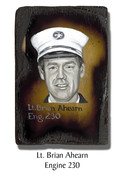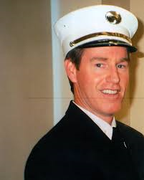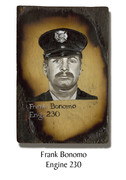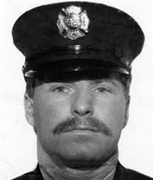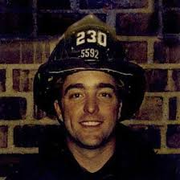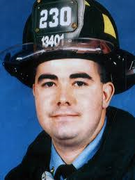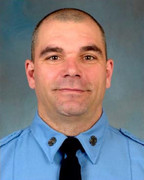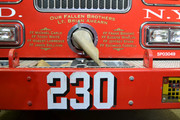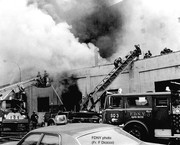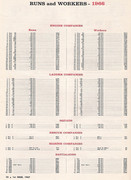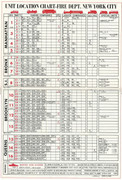Engine 222/Battalion 37 firehouse 32 Ralph Avenue Bedford Stuyvesant/Bushwick, Brooklyn Division 15, Battalion 37 "Triple Deuce"
Engine 22 BFD organized 836 Quincy Street 1885
Engine 22 BFD became Engine 22 FDNY 1898
Engine 22 became Engine 122 1899
Engine 122 moved to 650 Hart Street at Engine 118 (later Engine 218) 1904
Engine 122 returned to 836 Quincy Street 1905
Engine 122 became Engine 222 1913
Engine 222 new firehouse 32 Ralph Avenue w/Battalion 37 1973
Engine 222 moved to 25 Rockaway Avenue at Engine 233 2001
Engine 222 moved to 32 Ralph Avenue w/Battalion 37 2002
Battalion 37 organized 650 Hart Street at Engine 118 (later Engine 218) 1906
Battalion 37 moved to 836 Quincy Street at Engine 222 1949
Battalion 37 new firehouse 32 Ralph Avenue w/Engine 222 1973
Battalion 37 moved to 25 Rockaway Avenue at Engine 233 2001
Battalion 37 moved to 32 Ralph Avenue w/Engine 222 2002
Battalion 37-2 organized 836 Quincy Street at Engine 222 1968
Battalion 37-2 disbanded to form Battalion 28 1969
Battalion 28 organized 836 Quincy Street at Engine 222 1969
Battalion 28 moved to 392 Himrod Street at Engine 271 1971
RAC 2 organized 32 Ralph Avenue at Engine 222 1996
RAC 2 moved to 165 Bradford Street at Engine 332 2001
Engine 22 BFD:

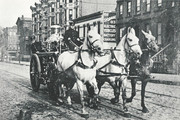
ENGINE COMPANY NO. 22- PROTECTORS OF BROWNSTONE FRONTS
ENGINE COMPANY NO. 22.
Located in one of the most aristocratic portions of the city of Brooklyn, the house occupied by Engine Company No. 22 on Quincy Street, near Patchen venue, in the Twenty-fifth Ward, is surrounded on all sides by handsome brownstone and frame private residences and first-class apartment houses.
The company was organized on June 16, 1885, by Fire Commissioner Richard H. POILLON. In the district covered by it on a first-alarm there are 64 boxes, which are distributed about in the territory lying between the city line on the north. Myrtle Avenue and Broadway on the east, Atlantic Avenue on the south and Stuyvesant Avenue on the west, in all about three miles
square.
In this territory besides the hundreds of elegant private residences arc the House of the Good Shepherd, Lutheran Home for Aged Women, Warner Institute, Public Schools Nos. 26, 74 and 75, Bohannan's immense lock factory. Church of Our Lady of Good Counsel, of which Rev. Father Mahoney is pastor, the Reid Avenue Methodist Episcopal church, and any number of smaller churches, DeKaIb Avenue car stables, Green and Gates Avenue car stables, Ebert's brewery and Eppigs brewery. It is in this district that County Clerk COTTIER, School Trustee Ferns and George GLENDENNING, the leader of the Twenty-fifth Ward, reside.
The majority of the men in the company have been in the service for many years and notwithstanding this fact they have fortunately escaped serious bodily harm and with but one exception have not been called upon to rescue a fellow being cut off by flame and smoke.
Foreman JOHN A. KEVENY was born in the County Roscommon, Ireland, on May 6, 1847, and came with his parents to Brooklyn when he was six years of age, and settled in the Fifteenth Ward. He attended Public School No. 18 and completed his education at the Parochial School attached to Father Malone's parish. After being three years in the Custom House as a broker's clerk, he engaged in a more lucrative business, which he pursued up to the time of his appointment to the Fire Department on Dec. 31, 1869. He was assigned to duty with Engine Company No. 11, then transferred to Engine No. 9 and subsequently back to Engine No. 11, from which company he was detailed to the Kerosene Bureau for three years as an Inspector. He gave up his position in the Kerosene Bureau on March 1, 1887, to become Assistant Foreman of Engine Company No. 11, and while holding that rank he was, on July 1, 1889, promoted to the rank of Foreman and sent to take command of this company. When the Civil War broke out he went out with the 56th Regiment New York State Militia, and received an honorable discharge when the regiment was mustered out of service. As a volunteer fireman he as ran for two years with Victory Engine No. 13. During his long period of service in the Department he has escaped injury.
Assistant Foreman JAMES L. HAVILAND was born in Brooklyn on Jan. 28, 1848, and became a fireman on Feb. 8, 1876. He was assigned as a private to Engine Company No. 17.On Jan. 15, 1882, he was promoted to the grade of engineer, and on March 1, 1887, he was made Assistant Foreman, which position he held up to June 1, 1891, when he was transferred to No. 22. While a private in No. 17 he was accidentally knocked off a wagon and had his head so badly cut that he was unable to do duty for over two months.
Engineer TIMOTHY J. DOLAN was born in the County Roscommon, Ireland, on Washington s Birthday, 1840. For five years, 1862-67, he was actively engaged in the United States Revenue Marine Service in looking for smugglers. He was appointed a fireman on July 9, 1872, and assigned as engineer to No. 13. At the organization of Engine Company No. 19, he was transferred there and later sent back to Engine No. 13 where he remained until the organization of this company.
EDWARD BOERUM, the stoker, was born in the city of Brooklyn, on April 25, 1842. He fought in the Civil War, with the 47th New York Volunteers, from 1861 to 1864, and at the battle of Cold Harbor, Virginia, was wounded in the right shoulder. On Feb. 15, 1879, he was appointed a fireman and assigned to duty with Engine Company No. 9, where he remained up to the time of the
organization of this company. While a member of Engine No. 9 one of the horses kicked him on the left knee joint and seriously injured him. A year later, on the way to a fire, a DeKalb Avenue car ran into the tender and upset it, and Mr. BOERUM received severe injuries to his spine.

THOMAS J. McCUE, the driver of the engine, was born in the Fourteenth Ward of Brooklyn, on Nov. 19, 1863. He became a member of the uniformed force, on Sept. 7, 1887, and has served continuously since that time with Engines Nos. 11, 21 and 22. At the fire in Bartlett's stores, in July, 1890, Mr. McCUE was so badly overcome by the heat and smoke that his life, for a time,
was despaired of.
JOHN MACKIN is one of the old-timers of the new Department. He was a volunteer fireman as well, and in the dark days of the Rebellion for twenty months shouldered his musket with his comrades of the 12 5th New York Volunteers and marched with them into the thickest of the fight. For another year he served his country well and faithfully on board the transport steamer "Corwin." When peace was restored he returned to his home and joined with his friends and neighbors in the grand work of saving the lives and property of Brooklyn's citizens. When the Legislature of the State of New York did away with the old system, John MACKIN was among the number of ''old vamps" who made application to the first Board of Fire Commissioners for appointment in the Paid Department. He was a successful candidate and on Aug.18, 1870, he donned the uniform and began his new career with Hook and Ladder Company No. 3, and remained in that company until Engine No. 22 was organized. At a fire on Doughty Street, when he was a member of Truck No. 3, Mr. MACKIN found an unconscious woman on the top floor of the burning dwelling and carried her down the ladder to the street. He afterward assisted in rescuing three other members of the same family who had been overpowered by the heat and smoke.
WILLIAM FOLEY was born in the Thirteenth Ward of Brooklyn, on June 23, 1853, nd became a fireman on Jan. 24, 1887. Since that time he has done duty with Engine No. 21 and Hook and Ladder No. 4 and was transferred from the latter to Engine No. 22, in May, 1890.
BRYAN DUHIGG was born in County Limerick. Ireland, on Dec. 18, 1841. He was made a fireman on April 22, 1878, and when Engine Company No. 22 was organized he was transferred from Engine Company No. 18, of which company he had been a member from the time of his appointment.
CLATUS BURKE was born in the old Ninth Ward of Brooklyn, and is one of the late appointees to the Department. He first donned the uniform on July 17 1891 and was assigned to this company.
BENJAMIN F DELAMATER was born in the city of New York, on Oct. 28, 1841, and prior to becoming a fireman, on April 20, 1878, he served in the United States Navy. He was a member of Engine Company No. 13 when his transfer to this company took place.
DANIEL R. KETCHAM was born in New York City on Sept. 9, 1833. He was appointed a member of the new Department when it was organized and did duty with Engine Company No. 11, up to the time of his transfer to this company. He is now detailed to the Kerosene Bureau as an Inspector.
FRANK PYBUS HART was born in New York City on Jan. 20, 1857, and he has been connected with the uniformed force since Aug. 11, 1891.
MICHAEL LANGAN was born in Ireland on March 11, 1844. He was appointed bell-ringer Dec. 2, 1879. When that branch of the Department was abolished he was assigned to duty with this company, where he remained in active service up to June 12, 1892, when he was transferred to Engine Company No. 18.
ANDREW TENNANT was born in Boston, Mass., on Oct. 26, 1847. He became a fireman on the date of the organization of the present Department, and is detailed from this company to the Repair-shop.
The men who compose this company are intelligent, active and fearless, and are in ever, way a credit to the Department. They are equipped with a second-class Amoskeag engine, a two wheel hose-cart and three well-trained horses. Since the company has been organized they have had several fires which have been both wearisome and perilous. Among them were those at
Pratt's oil works' Adelphi Academy, Bartlett's stores, Remsen's carriage factory, Stover's dry goods' house' the Warner Institute, the Commercial Street sugar house, and in Smith, Gray & Company's building at junction of Flatbush Avenue, Fulton and Nevins Streets. (from Our Firemen - the Official History of the Brooklyn Fire Department)
Engine 22 BFD - horses respond without engine - 1896:

836 Quincy Street:
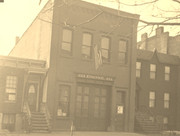

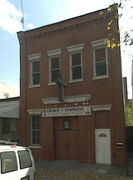
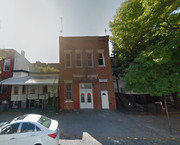
Engine 22 BFD organized 836 Quincy Street 1885
Engine 22 BFD became Engine 22 FDNY 1898
Engine 22 became Engine 122 1899
Engine 122 moved to 650 Hart Street at Engine 118 (later Engine 218) 1904
Engine 122 returned to 836 Quincy Street 1905
Engine 122 became Engine 222 1913
Engine 222 new firehouse 32 Ralph Avenue w/Battalion 37 1973
Engine 222 moved to 25 Rockaway Avenue at Engine 233 2001
Engine 222 moved to 32 Ralph Avenue w/Battalion 37 2002
Battalion 37 organized 650 Hart Street at Engine 118 (later Engine 218) 1906
Battalion 37 moved to 836 Quincy Street at Engine 222 1949
Battalion 37 new firehouse 32 Ralph Avenue w/Engine 222 1973
Battalion 37 moved to 25 Rockaway Avenue at Engine 233 2001
Battalion 37 moved to 32 Ralph Avenue w/Engine 222 2002
Battalion 37-2 organized 836 Quincy Street at Engine 222 1968
Battalion 37-2 disbanded to form Battalion 28 1969
Battalion 28 organized 836 Quincy Street at Engine 222 1969
Battalion 28 moved to 392 Himrod Street at Engine 271 1971
RAC 2 organized 32 Ralph Avenue at Engine 222 1996
RAC 2 moved to 165 Bradford Street at Engine 332 2001
Engine 22 BFD:


ENGINE COMPANY NO. 22- PROTECTORS OF BROWNSTONE FRONTS
ENGINE COMPANY NO. 22.
Located in one of the most aristocratic portions of the city of Brooklyn, the house occupied by Engine Company No. 22 on Quincy Street, near Patchen venue, in the Twenty-fifth Ward, is surrounded on all sides by handsome brownstone and frame private residences and first-class apartment houses.
The company was organized on June 16, 1885, by Fire Commissioner Richard H. POILLON. In the district covered by it on a first-alarm there are 64 boxes, which are distributed about in the territory lying between the city line on the north. Myrtle Avenue and Broadway on the east, Atlantic Avenue on the south and Stuyvesant Avenue on the west, in all about three miles
square.
In this territory besides the hundreds of elegant private residences arc the House of the Good Shepherd, Lutheran Home for Aged Women, Warner Institute, Public Schools Nos. 26, 74 and 75, Bohannan's immense lock factory. Church of Our Lady of Good Counsel, of which Rev. Father Mahoney is pastor, the Reid Avenue Methodist Episcopal church, and any number of smaller churches, DeKaIb Avenue car stables, Green and Gates Avenue car stables, Ebert's brewery and Eppigs brewery. It is in this district that County Clerk COTTIER, School Trustee Ferns and George GLENDENNING, the leader of the Twenty-fifth Ward, reside.
The majority of the men in the company have been in the service for many years and notwithstanding this fact they have fortunately escaped serious bodily harm and with but one exception have not been called upon to rescue a fellow being cut off by flame and smoke.
Foreman JOHN A. KEVENY was born in the County Roscommon, Ireland, on May 6, 1847, and came with his parents to Brooklyn when he was six years of age, and settled in the Fifteenth Ward. He attended Public School No. 18 and completed his education at the Parochial School attached to Father Malone's parish. After being three years in the Custom House as a broker's clerk, he engaged in a more lucrative business, which he pursued up to the time of his appointment to the Fire Department on Dec. 31, 1869. He was assigned to duty with Engine Company No. 11, then transferred to Engine No. 9 and subsequently back to Engine No. 11, from which company he was detailed to the Kerosene Bureau for three years as an Inspector. He gave up his position in the Kerosene Bureau on March 1, 1887, to become Assistant Foreman of Engine Company No. 11, and while holding that rank he was, on July 1, 1889, promoted to the rank of Foreman and sent to take command of this company. When the Civil War broke out he went out with the 56th Regiment New York State Militia, and received an honorable discharge when the regiment was mustered out of service. As a volunteer fireman he as ran for two years with Victory Engine No. 13. During his long period of service in the Department he has escaped injury.
Assistant Foreman JAMES L. HAVILAND was born in Brooklyn on Jan. 28, 1848, and became a fireman on Feb. 8, 1876. He was assigned as a private to Engine Company No. 17.On Jan. 15, 1882, he was promoted to the grade of engineer, and on March 1, 1887, he was made Assistant Foreman, which position he held up to June 1, 1891, when he was transferred to No. 22. While a private in No. 17 he was accidentally knocked off a wagon and had his head so badly cut that he was unable to do duty for over two months.
Engineer TIMOTHY J. DOLAN was born in the County Roscommon, Ireland, on Washington s Birthday, 1840. For five years, 1862-67, he was actively engaged in the United States Revenue Marine Service in looking for smugglers. He was appointed a fireman on July 9, 1872, and assigned as engineer to No. 13. At the organization of Engine Company No. 19, he was transferred there and later sent back to Engine No. 13 where he remained until the organization of this company.
EDWARD BOERUM, the stoker, was born in the city of Brooklyn, on April 25, 1842. He fought in the Civil War, with the 47th New York Volunteers, from 1861 to 1864, and at the battle of Cold Harbor, Virginia, was wounded in the right shoulder. On Feb. 15, 1879, he was appointed a fireman and assigned to duty with Engine Company No. 9, where he remained up to the time of the
organization of this company. While a member of Engine No. 9 one of the horses kicked him on the left knee joint and seriously injured him. A year later, on the way to a fire, a DeKalb Avenue car ran into the tender and upset it, and Mr. BOERUM received severe injuries to his spine.

THOMAS J. McCUE, the driver of the engine, was born in the Fourteenth Ward of Brooklyn, on Nov. 19, 1863. He became a member of the uniformed force, on Sept. 7, 1887, and has served continuously since that time with Engines Nos. 11, 21 and 22. At the fire in Bartlett's stores, in July, 1890, Mr. McCUE was so badly overcome by the heat and smoke that his life, for a time,
was despaired of.
JOHN MACKIN is one of the old-timers of the new Department. He was a volunteer fireman as well, and in the dark days of the Rebellion for twenty months shouldered his musket with his comrades of the 12 5th New York Volunteers and marched with them into the thickest of the fight. For another year he served his country well and faithfully on board the transport steamer "Corwin." When peace was restored he returned to his home and joined with his friends and neighbors in the grand work of saving the lives and property of Brooklyn's citizens. When the Legislature of the State of New York did away with the old system, John MACKIN was among the number of ''old vamps" who made application to the first Board of Fire Commissioners for appointment in the Paid Department. He was a successful candidate and on Aug.18, 1870, he donned the uniform and began his new career with Hook and Ladder Company No. 3, and remained in that company until Engine No. 22 was organized. At a fire on Doughty Street, when he was a member of Truck No. 3, Mr. MACKIN found an unconscious woman on the top floor of the burning dwelling and carried her down the ladder to the street. He afterward assisted in rescuing three other members of the same family who had been overpowered by the heat and smoke.
WILLIAM FOLEY was born in the Thirteenth Ward of Brooklyn, on June 23, 1853, nd became a fireman on Jan. 24, 1887. Since that time he has done duty with Engine No. 21 and Hook and Ladder No. 4 and was transferred from the latter to Engine No. 22, in May, 1890.
BRYAN DUHIGG was born in County Limerick. Ireland, on Dec. 18, 1841. He was made a fireman on April 22, 1878, and when Engine Company No. 22 was organized he was transferred from Engine Company No. 18, of which company he had been a member from the time of his appointment.
CLATUS BURKE was born in the old Ninth Ward of Brooklyn, and is one of the late appointees to the Department. He first donned the uniform on July 17 1891 and was assigned to this company.
BENJAMIN F DELAMATER was born in the city of New York, on Oct. 28, 1841, and prior to becoming a fireman, on April 20, 1878, he served in the United States Navy. He was a member of Engine Company No. 13 when his transfer to this company took place.
DANIEL R. KETCHAM was born in New York City on Sept. 9, 1833. He was appointed a member of the new Department when it was organized and did duty with Engine Company No. 11, up to the time of his transfer to this company. He is now detailed to the Kerosene Bureau as an Inspector.
FRANK PYBUS HART was born in New York City on Jan. 20, 1857, and he has been connected with the uniformed force since Aug. 11, 1891.
MICHAEL LANGAN was born in Ireland on March 11, 1844. He was appointed bell-ringer Dec. 2, 1879. When that branch of the Department was abolished he was assigned to duty with this company, where he remained in active service up to June 12, 1892, when he was transferred to Engine Company No. 18.
ANDREW TENNANT was born in Boston, Mass., on Oct. 26, 1847. He became a fireman on the date of the organization of the present Department, and is detailed from this company to the Repair-shop.
The men who compose this company are intelligent, active and fearless, and are in ever, way a credit to the Department. They are equipped with a second-class Amoskeag engine, a two wheel hose-cart and three well-trained horses. Since the company has been organized they have had several fires which have been both wearisome and perilous. Among them were those at
Pratt's oil works' Adelphi Academy, Bartlett's stores, Remsen's carriage factory, Stover's dry goods' house' the Warner Institute, the Commercial Street sugar house, and in Smith, Gray & Company's building at junction of Flatbush Avenue, Fulton and Nevins Streets. (from Our Firemen - the Official History of the Brooklyn Fire Department)
Engine 22 BFD - horses respond without engine - 1896:

836 Quincy Street:





